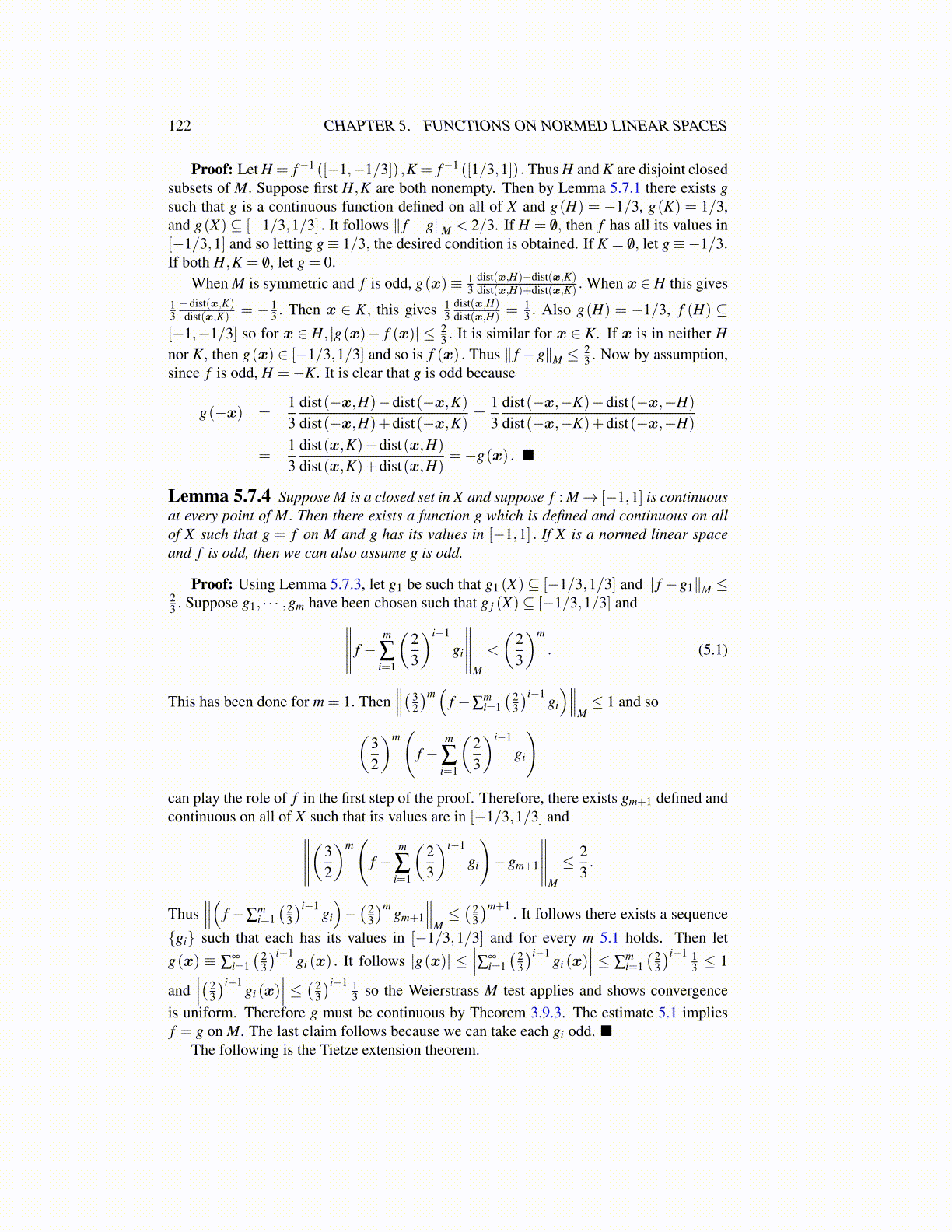
122 CHAPTER 5. FUNCTIONS ON NORMED LINEAR SPACES
Proof: Let H = f−1 ([−1,−1/3]) ,K = f−1 ([1/3,1]) . Thus H and K are disjoint closedsubsets of M. Suppose first H,K are both nonempty. Then by Lemma 5.7.1 there exists gsuch that g is a continuous function defined on all of X and g(H) = −1/3, g(K) = 1/3,and g(X)⊆ [−1/3,1/3] . It follows ∥ f −g∥M < 2/3. If H = /0, then f has all its values in[−1/3,1] and so letting g≡ 1/3, the desired condition is obtained. If K = /0, let g≡−1/3.If both H,K = /0, let g = 0.
When M is symmetric and f is odd, g(x)≡ 13
dist(x,H)−dist(x,K)dist(x,H)+dist(x,K) . When x ∈H this gives
13−dist(x,K)dist(x,K) = − 1
3 . Then x ∈ K, this gives 13
dist(x,H)dist(x,H) =
13 . Also g(H) = −1/3, f (H) ⊆
[−1,−1/3] so for x ∈ H, |g(x)− f (x)| ≤ 23 . It is similar for x ∈ K. If x is in neither H
nor K, then g(x) ∈ [−1/3,1/3] and so is f (x) . Thus ∥ f −g∥M ≤ 23 . Now by assumption,
since f is odd, H =−K. It is clear that g is odd because
g(−x) =13
dist(−x,H)−dist(−x,K)
dist(−x,H)+dist(−x,K)=
13
dist(−x,−K)−dist(−x,−H)
dist(−x,−K)+dist(−x,−H)
=13
dist(x,K)−dist(x,H)
dist(x,K)+dist(x,H)=−g(x) . ■
Lemma 5.7.4 Suppose M is a closed set in X and suppose f : M→ [−1,1] is continuousat every point of M. Then there exists a function g which is defined and continuous on allof X such that g = f on M and g has its values in [−1,1] . If X is a normed linear spaceand f is odd, then we can also assume g is odd.
Proof: Using Lemma 5.7.3, let g1 be such that g1 (X)⊆ [−1/3,1/3] and ∥ f −g1∥M ≤23 . Suppose g1, · · · ,gm have been chosen such that g j (X)⊆ [−1/3,1/3] and∥∥∥∥∥ f −
m
∑i=1
(23
)i−1
gi
∥∥∥∥∥M
<
(23
)m
. (5.1)
This has been done for m = 1. Then∥∥∥( 3
2
)m(
f −∑mi=1( 2
3
)i−1gi
)∥∥∥M≤ 1 and so
(32
)m(
f −m
∑i=1
(23
)i−1
gi
)can play the role of f in the first step of the proof. Therefore, there exists gm+1 defined andcontinuous on all of X such that its values are in [−1/3,1/3] and∥∥∥∥∥
(32
)m(
f −m
∑i=1
(23
)i−1
gi
)−gm+1
∥∥∥∥∥M
≤ 23.
Thus∥∥∥( f −∑
mi=1( 2
3
)i−1gi
)−( 2
3
)mgm+1
∥∥∥M≤( 2
3
)m+1. It follows there exists a sequence
{gi} such that each has its values in [−1/3,1/3] and for every m 5.1 holds. Then letg(x) ≡ ∑
∞i=1( 2
3
)i−1gi (x) . It follows |g(x)| ≤
∣∣∣∑∞i=1( 2
3
)i−1gi (x)
∣∣∣ ≤ ∑mi=1( 2
3
)i−1 13 ≤ 1
and∣∣∣( 2
3
)i−1gi (x)
∣∣∣ ≤ ( 23
)i−1 13 so the Weierstrass M test applies and shows convergence
is uniform. Therefore g must be continuous by Theorem 3.9.3. The estimate 5.1 impliesf = g on M. The last claim follows because we can take each gi odd. ■
The following is the Tietze extension theorem.